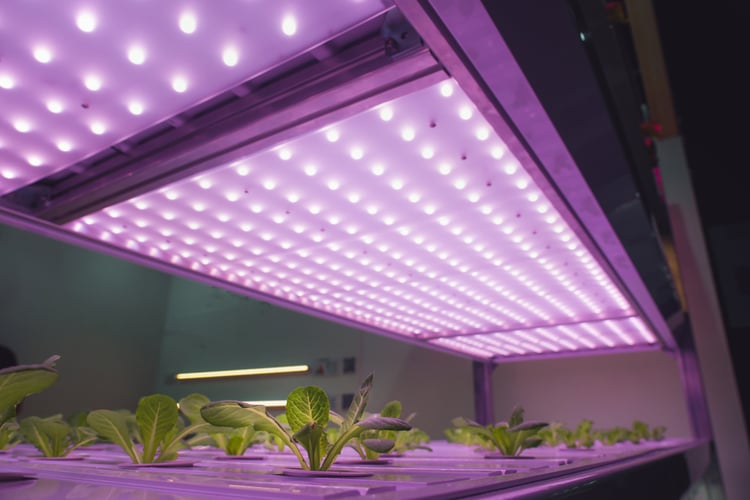3 Things To Consider Before Building a Cannabis Cultivation Facility

The US cannabis market reached a size of $10.8 billion in 2021, according to a study by Grand View Research. They also forecast that the industry will reach $40 billion by 2030, which represents a compound annual growth rate (CAGR) of 14.9%. The growth of the cannabis industry can be attributed to two main factors: increasing medical applications, and increasing legalization.
Indoor agriculture is a promising concept: crops can be grown in urban and suburban locations, bringing them closer to consumers. Growth operations can also be stacked vertically to use land more efficiently, and crops can be completely isolated from pests. Cannabis growers can benefit from these features of indoor growing facilities.
Planning a cannabis cultivation facility? Get a professional MEP design.
However, indoor cannabis cultivation also brings technical challenges, since the grower must create an optimal indoor environment. Lighting, temperature, and humidity must be controlled carefully to maximize yield and make the operation profitable. Here we will discuss 3 important design considerations before starting a cannabis growing facility.
1) Key Decision: New Facility or Repurposing an Existing Building?

One of the first decisions before starting a cannabis growing operation is deciding between a new construction or a repurposed building. Like in many business decisions, each option has advantages and disadvantages.
The main advantage of a completely new facility is being able to design a high-performance building envelope. Energy efficiency can save you thousands of dollars in HVAC and humidity control each month; this is especially true in the cannabis industry, where you cannot afford to switch off key systems. With the growing costs of electricity and natural gas, an efficient building envelope is an excellent investment.
The downside of a new construction is a higher upfront investment, and you can reduce project costs by repurposing an existing building. However, this also means that the building envelope might not be ideal, driving up your electricity and gas bills.
- If you decide to start a cannabis growing operation in a repurposed building, you should contact a qualified MEP engineering firm to get a professional inspection of the property.
- Getting a structural assessment is also recommended, so you can avoid buildings that will need expensive repairs or upgrades. Consider that an indoor growing operation involves adding mechanical equipment to existing structures.
Using a repurposed building for cannabis cultivation is viable if you can find a property with a suitable thermal envelope. On the other hand, if you use a building with deficient insulation and air leakage issues, upfront costs can increase drastically. These issues must be solved upfront, or your cannabis growing facility can suffer from low yield and high energy costs.
2) Importance of HVAC Design in Cannabis Growing

A cannabis growing facility needs to control indoor temperature and humidity 24/7, or otherwise you can suffer major losses - potential issues include low plant quality, low yield and mold infestation. To ensure adequate indoor conditions in your growing facility, a reliable and efficient HVAC installation is very important.
Since your facility will contain live plants, you will need additional systems beyond traditional HVAC equipment. This includes irrigation and carbon dioxide enrichment systems, along with the electrical and plumbing installations they need to operate. Like in any commercial building, you will also need a fire protection system.
Being familiarized with local building codes and regulations is important in any construction project, but especially in the fast-growing cannabis industry. A qualified design firm like NY Engineers can help you keep up with the changing requirements of state and city governments.
3) Designing an Optimal Lighting System for Cannabis Growth

Cannabis cultivation not only requires temperature and humidity control, but also suitable lighting conditions. Consider that the lighting needs of plants are very different from those of humans:
- In most commercial buildings, the main purposes of the lighting system are visibility and decoration.
- A cannabis cultivation facility must have a lighting system that creates optimal conditions for plant growth.
When designing a lighting system for humans, performance is described in terms of lumens and luxes - total amount of light, and light per square meter. In an indoor growing application, the lighting system must provide enough photosynthetically active radiation or PAR. In simple terms, PAR can be described as the portion of light that is useful for organisms capable of photosynthesis.
Cannabis cultivation facilities often use a combination of HPS and LED lamps to achieve optimal lighting conditions. These grow lights must be selected according to the specific radiation needs of each crop (cannabis in this case), and the fixture distribution must ensure optimal coverage.
Make sure your mechanical installations are code compliant and energy efficient, while getting a 50% faster turnaround. You can contact Nearby EngineersNew York Engineers by email (info@ny-engineers.com) or phone (786) 788-0295212-575-5300.

Michael Tobias
Michael Tobias, the Founding Principal of NY Engineers, currently leads a team of 50+ MEP/FP engineers and has led over 1,000 projects in the US
Join 15,000+ Fellow Architects and Contractors
Get expert engineering tips straight to your inbox. Subscribe to the NY Engineers Blog below.



